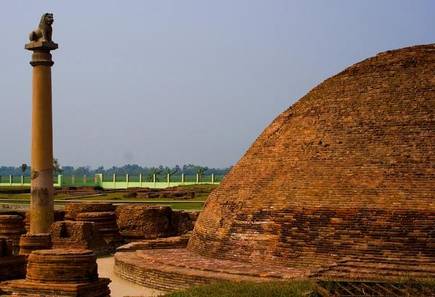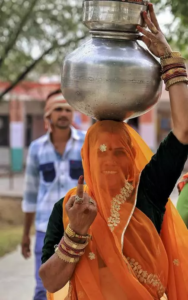The edicts of Asoka, the third Mauryan emperor , continue to hold relevance even today. At a time when India is busy blurring the distinction between history and mythology, T.M. Krishna, the noted Carnatic vocalist, writer and activist, has put to music four edicts of the Mauryan emperor Asoka. The dhamma edicts, which focus on the theme of equality and justice, have been rendered in the original Magadhi Prakrit, showing that certain values are timeless. Giving a touch of immediacy to “The Edict Project”, which was launched in collaboration with Asoka University, Krishna chose October 14, the day Dr B.R. Ambedkar embraced Buddhism, which is said to have been the state religion during the time of Asoka, to premier his edict song.
Talking of values, the principles, the ideology, in fact, even the genius of Asoka would have remained unknown but for the discovery of the Asokan edicts in the 19th century. Until 1837, when James Princep studied the edicts and deciphered them for students of history, Asoka was just another emperor of ancient India who ruled from 268 to 232 B.C. The discovery of the inscriptions changed it all.
The minor rock edicts, the minor pillar edicts and the major rock and pillars edicts, showed that Asoka was not only a great ruler but he was way ahead of the times. He preached peace and tolerance, justice and equality at a time when might was considered right. It was proved not once but many times over through his 120 edicts in Brahmi and Kharoshthi scripts.
The inscriptions were of two kinds: one set dealt with Asoka’s declarations as a lay Buddhist to the Buddhist Sangha, the other was about proclamations to the public at large, and kept at places where people were likely to gather in large numbers.
Little wonder, the historian Romila Thapar asked, “Had the Brahmi script not been deciphered what would have been the history of early India in which Asoka Maurya was absent?” Indeed, what!
In Indian Cultures as Heritage: Contemporary Pasts, Romila Thapar writes: “The edicts of Emperor Asoka that we quote today as valuable heritage, were unread and ignored for over a millennium until their script was deciphered in the early nineteenth century. That is a long cultural hiatus for the message that they carried of non-violence and tolerance from a king.”
Interestingly, when the edicts began to be read, nobody actually knew who their author was. When Princep deciphered an inscription written in Brahmi, the earliest known Indian script, in 1837, the inscription did not mention Asoka. Instead, it talked of ‘Piyadassi’. It took more than 70 years for the world to understand that Piyadassi was Asoka. This was made possible by another inscription discovered in 1915 in which he addressed himself as Asoka, Piyadassi. Then the puzzle began to solve itself, and soon, there stood before students of history the majestic ruler, who was now considered benevolent, a paragon of peace and tolerance, one who underwent a complete transformation after witnessing the bloodbath of Kalinga in 261 B.C. As he himself noted with anguish, “A hundred and fifty thousand were deported, a hundred thousand were killed, and many times that number perished.”
In fact, we get to know of Asoka’s transformation to a peace-loving monarch with a breadth of vision only through his edicts. Even as most historians have covered Asoka with much glory for his policy of dhamma, peace and harmony, it is also believed by others that Asoka’s policy was probably based on realpolitik of the age. Asked if historians are guilty of exaggerating the changes in Asoka’s personality post Kalinga, Shonaleeka Kaul, Professor, Centre for Historical Studies, Jawaharlal Nehru University, replied: “Some would say so, yes. He had already conquered the whole subcontinent, as it were, when he gave up war and embraced dhamma. So may be, it was a practical decision rather than an idealistic one. He remained a tough ruler. In an edict, he warned the forest dwellers that they should submit to him or face consequences.”
Different regions, different languages
Although found as far as Peshawar and Mysore, the edicts were mainly located in the Gangetic plains. Most of the pillar edicts were in the Brahmi script and the language used was Prakrit, considered a pan-Indian language at that time. In a remarkable case of cultural relativity though, Asoka used local language in different regions, or at least different shades of Prakrit in the Gangetic plains. In the north-western part of the empire, he used the Kharoshthi script, which was derived from the Aramaic script then prevalent in Iran. Further west, his inscriptions were in Aramaic and Greek. In the rest of the empire, they were in the Brahmi script. In their own way, they talk not just about the emperor’s willingness to give each region its due and respect people’s attachment to a particular language and script, they also explain the extent of the empire and the role Asoka may have played as far down as modern Tamil Nadu.
The point was beautifully outlined in A History of India by Romila Thapar more than 40 years ago: “Asoka mentions the people of the south with whom he was on friendly terms—the Cholas, Pandyas, Satiyaputras, and Keralaputras. There is a tradition that poetry in Tamil was first committed to writing in the third or second century B.C. by foreign immigrants, who are also associated with stone inscriptions. It is possible that Tamil may have been a spoken language without a script, until contact with the Mauryans introduced the Brahmi script to the speakers of Tamil.”
Asokan inscriptions help in understanding the world view of the Mauryan monarch. Not only was he on friendly terms with his southern neighbours, and sent emissaries to Ceylon (he is reported to have sent his son Mahinda and also sent a branch of the pipal tree under which Gautam Buddha attained enlightenment) he was aware of the world beyond the subcontinent. An inscription dated 256-255 B.C. talks of the Greeks. It reads, “…where reigns the Greek King named Amtiyoga and beyond the realm of that Amtiyoga in the lands of the four kings Tulamaya, Antekina, Maka, and Alikyashudala…” Later, Amtiyoga was identified as Antiochus II Theos of Syria, the grandson of Seleucus Nicator: Ptolemy II Philadelphus of Egypt.
Aware of the world far west from India, Asoka sent missions to Greece, helping in familiarising that part of the world with the subcontinent. The contact with the Greek kings was durable with at least three generations of kings on either side sending envoys and exchanging gifts. Similarly, there was close contact with Persia. In fact, historians feel the idea of rock inscriptions may have come from there. Romila Thapar writes in A History of Ancient India: “The idea of making rock-inscriptions may have come to Asoka after hearing about those of Darius. The occasional phrase reflects this, such as the opening form of address: Darius uses the expression: Thus saith the king Darius…. And Asoka writes; The king, the Beloved of the Gods, Piyadassi, speaks thus…”
Ethical values through edicts
With this expanse of vision, Asoka won the admiration of many. H.G. Wells lauded the ethical values he propagated through his edicts. The wheel of law, taken from his pillar inscription, came to be regarded as a national symbol.
Asoka is said to have founded Srinagar in Kashmir. Kalhana mentions him in his Rajatarangini but does not mention his edicts. Shonaleeka Kaul writes in The Making of Early Kashmir: “Asoka is indeed credited by the Rajatarangini with considerable significance in Kashmiri history via mention of the fact that he founded the city of Srinagari, which remained the capital of Kashmir for the next two millennia. Xuan Zang, the Buddhist traveller from China, who travelled all through Kashmir and into the plains of India in the 7th century CE, made the same claim about Asoka.”
According to her, “Though there are no Asokan edicts in Kashmir, those in neighbouring Gandhara were certainly inscribed in Kharoshthi along with Aramaic script of the Greek lands, the double use implying the local character and purpose of Kharoshthi. Indeed, from the hundreds of famous graffiti in the far north at Chilas, Gilgit and Hunza from the Saka-Kusana period to several sculpture inscriptions of the same time in Mathura, with Gandhara and Kashmir in between, Kharoshthi emerges as a regional script par excellence up till the 3rd century B.C.”
Therein lies the greatest success of Asokan edicts. Even in places where they have not been found, their existence in the vicinity has enabled historians to understand the domination of particular scripts and languages. As for dhamma, widely regarded as a policy of renunciation of violence, and abhorrence of killing animals, the world would not have known about it but for the discovery of the edicts.
Krishna’s “The Edict Project” could be a game changer in creating awareness about the inscriptions in the mind of the common man. At a time when intolerance, even lynching of the ‘other’, is becoming rampant, the edicts could remind us of the people we were, of the people we have become. Krishna says, “They carry the emperor’s vision of a humane society.”
❈ ❈ ❈
Excerpts from Interview with T.M. Krishna
Ziya Us Salam: What drew you to Asoka’s edicts? One cannot think of music when one sees the edicts?
T.M. Krishna: The truth is, like anybody else, I had not read Asoka’s edicts carefully. I had read about them in school, the usual lessons of Kalinga and the [Asoka’s] transformation after that. About a year ago, Gopal Gandhi [former Governor of West Bengal] in a conversation suggested to me that I read them again. I agreed. About eight months ago I started looking them up again. When I read them, it was quite emotional. I was moved by their message.
ZS: What did you read to understand the meaning of the edicts?
TMK: Well, there are translations of these edicts. There are multiple translations. I read translations, not commentaries. What came through was the sheer beauty and profundity of the individual. What really touched me was that Asoka was a normal human being. Yes, he was a king, but he was no god, not floating in the air. He was a real person grappling with real issues. There was something really tangible, something every human being could connect to. This was not a bhashan from some politician or somebody claiming to be a god. Somebody you cannot question.
Then I discovered something else. Often in life we do not draw together deeply philosophical or personal journeys of enlightenment with administration. I found that rare connection in Asoka. Like Dr Ambedkar, the personal seeking with the socio-political reality was there. It was extremely beautiful to find him talking about justice, equality, or when he talked about how different religions should treat each other.
ZS: Were you also drawn to the edicts because of the climate of increasing intolerance in India?
TMK: Absolutely. We live in times of hate. We live in times when politicians increase these divisions, these polarities. If you look at the politics of the BJP [Bharatiya Janata Party], the Central government, it is about increasing this disparity, this anger. Whether it is about Kashmir, the CAA [Citizenship Amendment Act]… it goes on. In this environment of hate, I thought it was very important to seek these kind [Asoka’s edicts] of thoughts again. My way of expression is music. That is what I am. My politics is my music, which is why I started working on these edicts.
ZS: Did you rope in experts to understand the edicts considering that most of them are in Prakrit or in various shades of Prakrit?
TMK: I was fortunate to have this Buddhist monk Sravasti Dhamika. She is an Australian Buddhist monk. And a Prakrit scholar, Dr Naresh Kirti. I worked with them on four edicts of dhamma.
ZS: Are these the edicts discovered in Allahabad?
TMK: No, they are from different locations. The edicts are found at 37 locations across the subcontinent, including Afghanistan, Pakistan, Nepal, Bangladesh and India. There are 14 edicts, which are repeated at a few places. Others are not repeated. Some are local in nature, others are about administration. If you look at the edicts, we find that they were written in Prakrit but spoken in different dialects of Prakrit. So many different dialects.
ZS: There is cultural relativity in these scripts. For instance, the script used in Peshawar was different from the one prevalent in Magadha.
TMK: Sure. Absolutely. It proved that we had a king who was sensitive to local language, local culture, local dialects. Therefore the edicts are in different variations. We edited them to create a consistency as they had to be sung together.
ZS: Did you learn Prakrit in order to sing the edicts?
TMK: I do not know Prakrit. I was dependent on Naresh Kirti. I worked with him for two months, getting different words right. A language spoken is very different from a language sung. In every language like Hindi, Bengali, Sanskrit, there is precedence. We have heard it. But it was not there for Prakrit. It was written and spoken about 2,200 years ago. Let’s remember, it is probably not just the first time that the edicts have been sung, it is probably the first time they have come out of the written form. I do not think people have even heard them.
ZS: So how did you find music for Prakrit? I am sure it would have been totally different from traditions of Hindustani or Carnatic music.
TMK: I learnt to first say them. When you hear a khayal in Hindustani, it is different because it is a language in practice. Here is a language not heard. It was a fascinating experience for me to try and get the rhythm of the language. Only after I had this, I thought of singing. I kept repeating the words, then I sang them.
ZS: It must have been difficult as the edicts do not have a rhythm.
TMK: Absolutely. Honestly speaking the edicts are not made for music. They were messages from a king, they were not poems. A poem has a certain rhythmic cadence into which I tap into. What do I tap into here? I tuned it by following the sound of the language. I am still learning. As I go on with this project, I will learn more.
ZS: How have your fellow artistes reacted to the challenge you took up?
TMK: They have all been positive. The response has been wonderful even among musicians.
ZS: I am sure nobody else would have had the guts to sing the edicts.
TMK: (Laughs) It is also a part of the politics I am deeply involved in. We live in times of exclusion. The right-wing politics is about uniformity, trying to demolish everything else. It is opposed to pluralism. In this time, Asoka represents everything. He represents India. We forget he is so closely knit together with the fabric of India. From a flag to a symbol, he is so central to India. Therefore, to bring him back in public discourse was important.
ZS: The fact that you talk of bringing Asoka back is a sad comment on our polity.
TMK: Correct. I completely agree with you. Our history books do not tell us enough about Asoka, too.
ZS: But for these edicts we would have not known about the greatness of Asoka.
TMK: Absolutely. He would have been just another monarch. I believe the edicts should be taught in schools, they should be translated into every language. School children should be reciting the edict on equality among religions. Like we learn multiplication tables, we should have learnt five edicts of Asoka, their beautiful social and political message. They carry the emperor’s vision of a humane society, something we need badly.
(Ziya Us Salam is a noted literary and social commentator. Article courtesy: Frontline)




